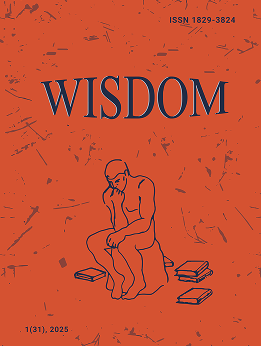Interpretation of Fate and Guilt in Armenian and European Epics
DOI:
https://doi.org/10.24234/wisdom.v22i2.805Keywords:
“Sasna Tsrer”, epic fate, sin, state, sin and freedom, personalized fateAbstract
The subject of the current article is that, for the first time in the study, the issues of the relationship between fate and sin in European-Armenian heroic epics were analyzed using historical, comparative methods.
Perceptions of both fate and guilt are quite different in French, German, Spanish and Armenian epics. This approach examines the works of epic heritage, not so much external plot similarities and differences but internal worldview perceptions.
The purpose of the study is to reveal the internal commonalities and peculiarities between European and Armenian epics.
As a result, the authors put forward the thesis that, in European epics, fate is alienated from a person and is personified in “Sasna Tsrer”, it originates from the individual and returns to him and is not personified. As a result, in European epics, guilt is seen as a consequence of an act; in “Sasna Tsrer”, guilt is a state that turns into a national destiny.
Downloads
References
Abeghyan, M. (1890). Azgayin vep (National novel, in Armenian). Yerevan: Murch.
Armenian mythology Nar (Tsovinar). (1985). Yerevan.
Astvatsashunchí (Bible, in Armenian). (2018). Yerevan: Nor Ararat.
Avdalbekyan, T. (1929) Mihry hayotsí mej (Mihr among Armenians, in Armenian). Vienna: Mkhitarean Tparan.
Charents, Y. (1987). Yerkeri zhoghovatsu chívors hatorov (Collection of works in 4 Vol., in Armenian). Yerevan.
Edoyan, H. (2009). Sharzhum depi havasarakshrutíyun (Movement towards balance, in Armenian). Yerevan: Sargis Khachents.
Frick (1987). Ynddem falakíin, Hay dasakan kínarergutíyun (Against Falak, Armenian classical lyric poetry, in Armenian). (Vol. II) Yerevan.
Gaydenko, P. (1997). Proryv k transtsendentnomu (Breakthrough to the transcendent, in Russian). Moscow: Iskusstvo.
Grigoryan, G. (1960). Hay zhoghovrdakan herosakan epos (Armenian folk heroic epic, in Armenian). Yerevan: Haykakan SSRGA.
Grigoryan, V. (2019). Levon Khechoyani steghtsagortsutíyuny (Works by Levon Khechoyan, in Armenian). Yerevan: Armav.
Gurevich, A. (1994). Dialektika sudíby u germantsev i drevnikh skandinavov (Dialectics of fate among the Germans and ancient Scandinavians, in Armenian). ?oscow: Voprosy Statistiki.
Harutyunyan, S. (1977). Sasna Tsrrer. zhoghovrdakan vep (Sasna Tsrer, epic poem, in Armenian). Yerevan: Haypethrat.
Hegel (1971). Estetika (Aesthetics, in Russian). ?oscow: Iskusstvo.
Homer (1987). Iliakan (Iliad, in Armenian). Yerevan: Publication of Yerevan State University.
Ibsen, G. (1971). Sobr. sochineniy v 4-kh tomakh (Collection of essays in 4 vol., in Russian). ?oscow: Iskusstvo.
Isahakyan, Av. (1952). Sasma Mher (Sasma Mher, in Armenian). Beirut: K. Tonikyan.
Koghbatsi, Y. (1994). Yeghts aghandotsí (False sect, in Armenian). Yerevan: Publication of Yerevan State University.
Nerses Shnorhali (1828). Meknutíiwn yeotíantsí tíghtívotsí katíughikeaytsí (Commentary by seven catholicos, in Armenian). Constantinople: Abraham Terzyan.
Peshkov, A. (2009). Khristianskoe ponimanie grekh, Trudy Nizhegorodskoy Dukhovnoy seminarii (Christian understanding of sin, Proceedings of the Nizhny Novgorod Theological Seminary, in Russian). (Vol. 07). Nijni Novgorod: Trudy Nizhegorodskoy dukhovnoy seminarii.
Ricoeur, P. (2002). Konflikty interpretatsiy (Interpretation conflicts, in Russian). Moscow: Kanon-Press C.
Sasna Tsrer (The Crazies from Sasoon, in Armenian) (1979). (Vol. 3). Yerevan: Haykakan SSRGA.
Sasuntsíi Davití (Davit from Sasun, in Armenian). (1981). Yerevan: Luys.
Shpidlik, F., (2000). Dukhovnaya traditsiya vostochnogo khristianstva (The spiritual tradition of eastern Christianity, in Russian). Moscow: Dar.
Srvandztyants, G. (1974). Grotsí u brotsí yev Sasuntsíi Dawití kam Mheri durr (Writings about David of Sassoun or Mherís door, in Armenian). Constantinople.
Tatevatsi, G., (1741). Amarran hator (Summer volume, in Armenian). Constantinople: Abraham Terzyan.
Theophan (1985). Zatvornik Vyshenskiy (Govorov), svt. Nachertaniye khristianskogo nravoucheniya (The hermit Vyshensky (Govorov), St. The outline of Christian morality, in Russian). Moscow: Sibirskaya Blagozvonnitsa.
Tumanyan, H. (1969). Yerkeri zhoghovatsu (Collection of works, in Armenian). (Vol. IV). Yerevan: Murch.
Yarkho, B. I. (1934). Pesní o Rolande, po oksfordskomu testu perevod so staro-frantsuzskogo vstupitelínaya statíya i primechaniya (Song about Roland, according to the Oxford text, translation from Old French introductory article and notes, in Russian). Moscow-Leningrad: Gosudarstvennoye izdatel'stvo.
Zarin, M. (1996). Asketizm po pravoslavno-khristianskomu ucheniyu (Asceticism according to Orthodox Christian teaching, in Russian). Moscow: Repr. vospr. izd.
Downloads
Published
How to Cite
Issue
Section
License
Copyright (c) 2022 scientific journal WISDOM

This work is licensed under a Creative Commons Attribution-NoDerivatives 4.0 International License.
Creative Commons Attribution-Non-Commercial (CC BY-NC). CC BY-NC allows users to copy and distribute the article, provided this is not done for commercial purposes. The users may adapt – remix, transform, and build upon the material giving appropriate credit, and providing a link to the license. The full details of the license are available at https://creativecommons.org/licenses/by-nc/4.0/.















